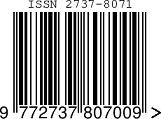Control of A Switched Reluctance Motor Based on Asymmetric Converter and Digital Signal Controller for Forward and Reverse Mode
Keywords:
SRM , Asymmetric Converter , Rotary Encoder , Phase Angle Ignition, Digital Signal ControllerAbstract
The Switched Reluctance Motor (SRM) is one of the best choices for industrial and electric vehicle applications, selected for its optimal performance. This is due to the advantages of SRM, including the use of permanent magnet-free technology and a simple construction consisting of an iron core on the rotor and stator windings. A rotary encoder is utilized to detect the rotor position due to its high precision. However, synchronization with the rotor position is required during installation to achieve optimal SRM performance. The rotor position obtained from the rotary encoder is processed by the digital signal controller to determine the firing angle on the rotor. The research objective is to control the SRM to rotate in both directions. To support this study, laboratory tests were conducted for validation by changing the phase sequence in the asymmetric converter, causing differences in the three-phase current waveforms for forward and reverse rotations. The results of this research show that the SRM can rotate bidirectionally.
Downloads
References
Y. Nakazawa, K. Ohyama, H. Fujii, H. Uehara, and Y. Hyakutake, “Improvement of Efficiency of Switched Reluctance Motor by Single Pulse Control Based on Linear Torque Equation.”
Siddhant College of Engineering and Institute of Electrical and Electronics Engineers, 2017 2nd International Conference for Convergence in Technology (I2CT).
C. Huang, G. Yang, H. Chen, and X. Liu, “Inhibitory effect of radial force to switched reluctance motor with stator pole slot,” in Proceedings - 14th International Conference on Computational Intelligence and Security, CIS 2018, Institute of Electrical and Electronics Engineers Inc., Dec. 2018, pp. 500–503. doi: 10.1109/CIS2018.2018.00119.
IEEE Industry Applications Society and Institute of Electrical and Electronics Engineers, 2017 20th International Conference on Electrical Machines and Systems (ICEMS)?: 11-14 Aug. 2017.
Institute of Electrical and Electronics Engineers, SPEEDAM 2018 - proceedings?: International Symposium on Power Electronics, Electrical Drives, Automation and Motion?: Amalfi (Italy), 20th-22nd June, 2018.
M. Dong, “Research on reduction the torque ripple in switched reluctance motor,” in Proceedings - 2016 IEEE International Symposium on Computer, Consumer and Control, IS3C 2016, Institute of Electrical and Electronics Engineers Inc., Aug. 2016, pp. 1071–1074. doi: 10.1109/IS3C.2016.270.
Da?nishga?h-i Shi?ra?z and Institute of Electrical and Electronics Engineers, 2019 10th International Power Electronics, Drive Systems and Technologies Conference (PEDSTC)?: Shiraz University, Iran, 12-14 Feb. 2019.
V. Wijaya and S. Riyadi, “Implementation of Input Capture Method on Switched Reluctance Motor to Obtain Precise Commutation Signals.”
S. Riyadi, “Regular paper A Control Strategy for SRM Drive to Produce Higher Torque and Reduce Switching Losses Electrical Electrical Electrical Electrical Systems Systems Systems Systems,” 2018.
C. Gong, S. Li, T. Habetler, J. Restrepo, and B. Soderholm, “Direct position control for ultrahigh-speed switched-reluctance machines based on low-cost nonintrusive reflective sensors,” in IEEE Transactions on Industry Applications, Institute of Electrical and Electronics Engineers Inc., Jan. 2019, pp. 480–489. doi: 10.1109/TIA.2018.2868037.
J. X. Wang and X. Cui, “Rotary Encoder Based Self-Positioning Method for Mobile Robot,” in Proceedings - 2018 5th International Conference on Information Science and Control Engineering, ICISCE 2018, Institute of Electrical and Electronics Engineers Inc., Jan. 2019, pp. 500–504. doi: 10.1109/ICISCE.2018.00111.
MC2D (Organization), Institute of Electrical and Electronics Engineers, IEEE Industry Applications Society, and IEEE Power & Energy Society, 2018 Thirteenth International Conference on Ecological Vehicles and Renewable Energies (EVER)?: 10-12 April 2018.
S. Riyadi, “A simple method to control the excitation angle for switched reluctance motor,” Indonesian Journal of Electrical Engineering and Informatics, vol. 9, no. 2, pp. 384–393, Jun. 2021, doi: 10.52549/ijeei.v9i2.2814.
S. Y. Wang, C. M. Lin, J. H. Chou, and F. Y. Liu, “Design of the adaptive sliding self-organizing cerebellar model articulation controller for switched reluctance motors,” in Proceedings - 2018 International Symposium on Computer, Consumer and Control, IS3C 2018, Institute of Electrical and Electronics Engineers Inc., Feb. 2019, pp. 145–148. doi: 10.1109/IS3C.2018.00044.
N. Yan, X. Cao, and Z. Deng, “Direct torque control for switched reluctance motor to obtain high torque-ampere ratio,” IEEE Transactions on Industrial Electronics, vol. 66, no. 7, pp. 5144–5152, Jul. 2019, doi: 10.1109/TIE.2018.2870355.
A. Wibisono, U. I. Katolik Soegijapranata Jl Pawiyatan Luhur, B. Dhuwur Semarang, and S. Riyadi, “PROtek?: Jurnal Ilmiah Teknik Elektro Kendali Kecepatan Switched Reluctance Motor Berbasis FPGA”, doi: 10.33387/protk.v9i2.4317.

Downloads
Published
How to Cite
Issue
Section
License
Copyright (c) 2024 Kevin Jhoni Andreas, Slamet Riyadi

This work is licensed under a Creative Commons Attribution 4.0 International License.
Copyright on any article in the International Journal of Engineering and Applied Physics is retained by the author(s) under the Creative Commons license, which permits unrestricted use, distribution, and reproduction provided the original work is properly cited.
License agreement
Authors grant IJEAP a license to publish the article and identify IJEAP as the original publisher.
Authors also grant any third party the right to use, distribute and reproduce the article in any medium, provided the original work is properly cited.














